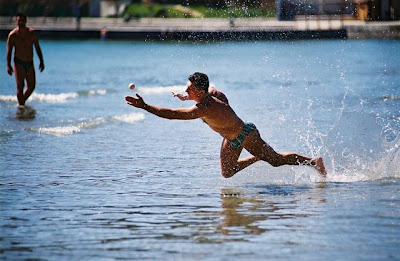 |
| Photo by www.croatiaweek.com |
One of the more curious sights for first-time visitors to Split's most popular beach resort at Bacvice is the sight of grown men in the sea lunging through the air in an attempt to keep a tiny ball from getting wet. The spectacle often causes comment from the uninitiated, unaware that they are watching a local sport older than famous football club Hajduk Split, and with its own World Championships - picigin (pronounced 'pi-tsi-GEEN')
Conceived in Split in 1908, the game has expanded elsewhere in the region, and picigin is played elsewhere on the coast, and in a more organised fashion in Medulin, Baska and Dubrovnik, as well as inland in the city of Osijek. Picigin has also extended beyond the Croatian borders, with clubs in Herceg Novi in Montenegro and Novi Sad in Serbia.
The aim of the game is to keep the ball in the air as long as possible and, as the game grows with intensity, passing tourists are treated to the spectacle of grown men flying the air in an often vain attempt to keep a small ball in the air. The ball (balun in local dialect) is a peeled tennis ball, and players make contact with the palm of the hand.
Picigin is a cross between volleyball and water polo, played in shallow water near the beach. It is not a competitive sport - there are no winners, points or opposing sides - but rather a relaxing way for friends to relax and exercise. Despite its non-competitive nature, the sport has hosted its own World Championships at Bacvice since 2005.
Why not introduce yourself and join in a game next time you see it played on the beach?


.jpg)
.jpg)
.jpg)
.jpg)
.jpg)
.jpg)



